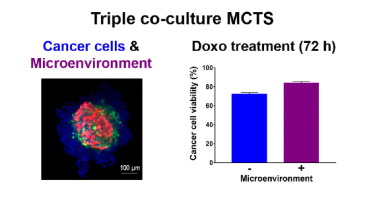Acta Biomaterialia ( IF 9.7 ) Pub Date : 2018-08-10 , DOI: 10.1016/j.actbio.2018.08.008 Gianpiero Lazzari , Valérie Nicolas , Michiya Matsusaki , Mitsuru Akashi , Patrick Couvreur , Simona Mura

|
The preclinical drug screening of pancreatic cancer treatments suffers from the absence of appropriate models capable to reproduce in vitro the heterogeneous tumor microenvironment and its stiff desmoplasia. Driven by this pressing need, we describe in this paper the conception and the characterization of a novel 3D tumor model, consisting of a triple co-culture of pancreatic cancer cells (PANC–1), fibroblasts (MRC–5) and endothelial cells (HUVEC), which assembled to form a hetero-type multicellular tumor spheroid (MCTS). By histological analyses and Selective Plain Illumination Microscopy (SPIM) we have monitored the spatial distribution of each cell type and the evolution of the spheroid composition. Results revealed the presence of a core rich in fibroblasts and fibronectin in which endothelial cells were homogeneously distributed. The integration of the three cell types enabled to reproduce in vitro with fidelity the influence of the surrounding environment on the sensitivity of cancer cells to chemotherapy. To our knowledge, this is the first time that a scaffold-free pancreatic cancer spheroid model combining both tumor and multiple stromal components has been designed. It holds the possibility to become an advantageous tool for a pertinent assessment of the efficacy of various therapeutic strategies.
Statement of significance
Pancreatic tumor microenvironment is characterized by abundant fibrosis and aberrant vasculature. Aiming to reproduce in vitro these features, cancer cells have been already co-cultured with fibroblasts or endothelial cells separately but the integration of both these essential components of the pancreatic tumor microenvironment in a unique system, although urgently needed, was still missing. In this study, we successfully integrated cellular and acellular microenvironment components (i.e., fibroblasts, endothelial cells, fibronectin) in a hetero-type scaffold-free multicellular tumor spheroid. This new 3D triple co-culture model closely mimicked the resistance to treatments observed in vivo, resulting in a reduction of cancer cell sensitivity to the anticancer treatment.
中文翻译:

基于三重共培养的多细胞球体:模仿胰腺肿瘤复杂性的新型3D模型
胰腺癌治疗的临床前药物筛选因缺乏能够在体外复制的合适模型而受到困扰异质性肿瘤微环境及其僵硬的异形增生。在这种迫切需求的驱动下,我们在本文中描述了一种新型3D肿瘤模型的概念和特征,该模型由胰腺癌细胞(PANC-1),成纤维细胞(MRC-5)和内皮细胞( (HUVEC),其组装形成异型多细胞肿瘤球体(MCTS)。通过组织学分析和选择性平原照明显微镜(SPIM),我们已经监控了每种细胞类型的空间分布以及球体成分的演变。结果显示存在富含成纤维细胞和纤连蛋白的核心,其中内皮细胞均匀分布。三种细胞类型的整合使其能够在体外繁殖忠实地考虑到周围环境对癌细胞对化学疗法敏感性的影响。据我们所知,这是首次设计出将肿瘤和多种基质成分结合在一起的无支架胰腺癌球体模型。它有可能成为对各种治疗策略的功效进行相关评估的有利工具。
重要声明
胰腺肿瘤微环境的特征是丰富的纤维化和异常的脉管系统。为了在体外重现这些特征,癌细胞已经与成纤维细胞或内皮细胞分别共培养,但是尽管迫切需要,但仍缺少将胰腺肿瘤微环境的这两个基本组成部分整合到一个独特的系统中的方法。在这项研究中,我们成功地将细胞和无细胞微环境组件(即成纤维细胞,内皮细胞,纤连蛋白)整合到无异型支架的多细胞肿瘤球体中。这种新的3D三重共培养模型密切模拟了对体内观察到的治疗的抵抗力, 导致癌细胞对抗癌治疗的敏感性降低。



























 京公网安备 11010802027423号
京公网安备 11010802027423号